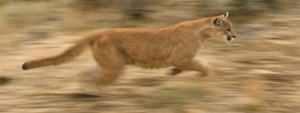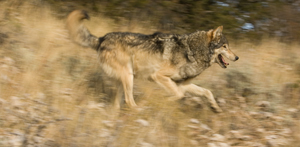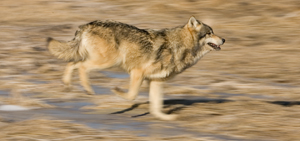Joe and Mary
Ann McDonald's
Wildlife Photography
February 2007
Question of the Month
What is the Best Shutter Speed for
Panning Running Mammals?
 Puma, Left, at 1/50th sec. Although
this is a useable image and conveys motion, the face of the puma
is not razor sharp. You'll note, also, that the legs almost disappear
as they're moving even faster. Legs can literally vanish at slow
shutter speeds, and that usually is not effective!
Puma, Left, at 1/50th sec. Although
this is a useable image and conveys motion, the face of the puma
is not razor sharp. You'll note, also, that the legs almost disappear
as they're moving even faster. Legs can literally vanish at slow
shutter speeds, and that usually is not effective!
Panning, as you all know, can imply a sense of motion as foreground,
background, and the area around the subject blurs, while the subject
(hopefully) stays sharply in focus. In contrast, fast shutter
speeds that freeze motion can reduce the sense of speed or motion
as the areas around the subject are more sharply delineated.
Panning requires some skill. If a subject is moving rapidly,
to insure a sharp focus, even at a fast shutter speed, you may
need to pan. For example, you'll be better off panning and following
the motion of a bald eagle swooping towards a fish that if you
had a stationary, motionless lens position. Even at fast shutter
speeds you'll probably see a blurred streak in the eye-highlights
of the eagle if the camera didn't follow the subject.
At slow shutter speeds, panning with the subject is absolutely
essential, but doing this correctly can be a challenge. Here's
how I pan, and usually get great results.
 Wolf, left, at 1/80th sec. Whether
the wolf wasn't moving as quickly, or the wolf's legs weren't
moving as fast, the legs are more clearly visible. Multiple shots
at 1/80th sec yielded similar results. You can learn virtually
everything you need to know to be a competent, skilled nature
photographer at our Digital
Complete Nature Photo Courses in Pennsylvania and in Arizona.
Wolf, left, at 1/80th sec. Whether
the wolf wasn't moving as quickly, or the wolf's legs weren't
moving as fast, the legs are more clearly visible. Multiple shots
at 1/80th sec yielded similar results. You can learn virtually
everything you need to know to be a competent, skilled nature
photographer at our Digital
Complete Nature Photo Courses in Pennsylvania and in Arizona.
With telephotos I use a Wimberley gimbal-style actionhead that
allows me to smoothly follow a subject while panning. I try to
keep some part of my subject consistently in the same focusing
bracket so that my panning speed and my subject's movement are
in synchrony, much as a hunter would keep the crosshairs of a
scope on the shoulder of a running deer, for example. If you ever
fired a rifle or shotgun you know that you have almost no chance
of hitting a moving target if your firearm doesn't follow the
subject. The same most assuredly applies to following a running
mammal with a telephoto lens.
Using a Wimberley head, or a regular ballhead if need be, allows
you to keep the telephoto on a consistent plane, and minimizes
the chance of up/down wobbling. If you're hand-holding your camera/lens
rig, you may indeed wobble, and the resulting image has a double-image,
unattractive blur effect.
Sometimes the up/down, rocking motion or gallop of your subject
may create this wobbly look, and there's nothing you can do about
that except use faster shutter speeds, but doing that may negate
the motion/pan effect you're looking for.
So, what is the best speed for panning a running mammal? 
The answer depends upon the speed of the animal. A skunk, for
example, won't cover ground as quickly as a fox or a deer, so
slower shutter speeds would be needed to create the sense of blur.
Conversely, a comparatively fast shutter speed could be used on
a galloping horse or pronghorn antelope and still achieve a blurred
background.
Badgers aren't very fast, but nevertheless
1/80th sec effectively created a nice plan blur.
 However,
for most mammals the size of a fox or larger 1/60th to 1/100th
sec will, on animals going at a reasonable pace for that animal,
create a very effective blur. Mind you, if an animal is really
bolting, running at top speed, you could probably double these
speeds to a minimum of 1/125th and a high of 1/250th. The accompanying
illustrations illustrate the effects.
However,
for most mammals the size of a fox or larger 1/60th to 1/100th
sec will, on animals going at a reasonable pace for that animal,
create a very effective blur. Mind you, if an animal is really
bolting, running at top speed, you could probably double these
speeds to a minimum of 1/125th and a high of 1/250th. The accompanying
illustrations illustrate the effects.
Both this wolf, and the one above, have
near razor-sharp faces at 1/80th sec., but the trick was effectively
following the wolf's horizontal motion with a smooth, steady pan.
Previous Questions
of the Month
KEY:
|
Exposure |
DIGITAL |
Camera Techniques |
Flash-Remotes |
In the Field |
NANPA |
Contact us by e-mail: hoothollow@acsworld.com
 Puma, Left, at 1/50th sec. Although
this is a useable image and conveys motion, the face of the puma
is not razor sharp. You'll note, also, that the legs almost disappear
as they're moving even faster. Legs can literally vanish at slow
shutter speeds, and that usually is not effective!
Puma, Left, at 1/50th sec. Although
this is a useable image and conveys motion, the face of the puma
is not razor sharp. You'll note, also, that the legs almost disappear
as they're moving even faster. Legs can literally vanish at slow
shutter speeds, and that usually is not effective! Wolf, left, at 1/80th sec. Whether
the wolf wasn't moving as quickly, or the wolf's legs weren't
moving as fast, the legs are more clearly visible. Multiple shots
at 1/80th sec yielded similar results. You can learn virtually
everything you need to know to be a competent, skilled nature
photographer at our
Wolf, left, at 1/80th sec. Whether
the wolf wasn't moving as quickly, or the wolf's legs weren't
moving as fast, the legs are more clearly visible. Multiple shots
at 1/80th sec yielded similar results. You can learn virtually
everything you need to know to be a competent, skilled nature
photographer at our 
 However,
for most mammals the size of a fox or larger 1/60th to 1/100th
sec will, on animals going at a reasonable pace for that animal,
create a very effective blur. Mind you, if an animal is really
bolting, running at top speed, you could probably double these
speeds to a minimum of 1/125th and a high of 1/250th. The accompanying
illustrations illustrate the effects.
However,
for most mammals the size of a fox or larger 1/60th to 1/100th
sec will, on animals going at a reasonable pace for that animal,
create a very effective blur. Mind you, if an animal is really
bolting, running at top speed, you could probably double these
speeds to a minimum of 1/125th and a high of 1/250th. The accompanying
illustrations illustrate the effects.